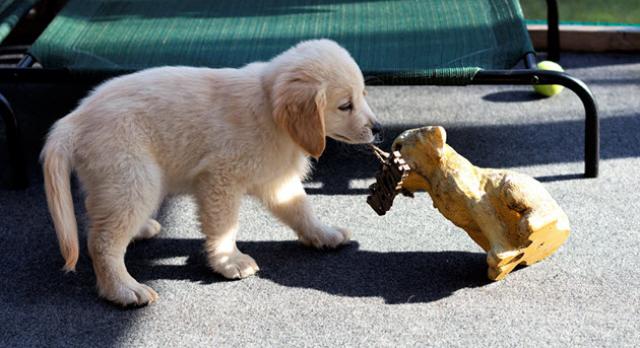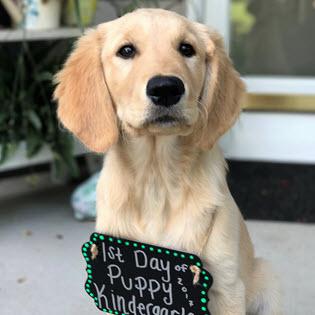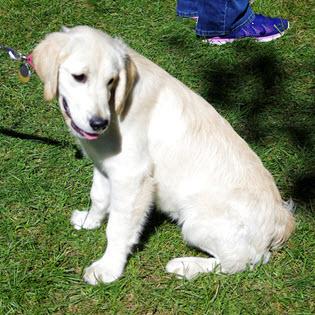Golden Retriever puppies are truly adorable and loads of fun. However, they also require of their humans a great deal of time, effort, and patience to grow into well-behaved and happy family members.
Well Worth the Considerable Effort
The hours you and your family spend training, socializing, and helping burn off all that puppy energy are well worth it. Not only will you raise a respectful family member who knows what is expected of him or her, your puppy will grow to be a happy and confident adult dog.
RAGOM requires that potential adopters of puppies plan for the following considerations before they apply, and the entire household needs to be on board with these plans before bringing their new family member home.
Obedience Training
Many unruly dogs are surrendered to RAGOM due to a lack of training. RAGOM considers training so important that we offer rebates to adopters who take their puppy to obedience and other training classes.
Training is not limited to teaching your dog to sit, lay down, stay, and come. Rather, truly effective training strengthens the bond between human and dog. It is a lifelong activity that teaches humans how to communicate with their dog, and teaches the dog to look to its human for direction in all environments and situations. A well-trained dog is both safer and easier to handle.
RAGOM only supports training methods based on positive reinforcement, which help establish the human as a leader—someone the dog can look to for guidance.
On the other hand, punishment-based or aversive training methods that use prong collars, choke chains, and shock devices can break down the trust between a dog and a human and interfere with the bonding process. RAGOM does not adopt to individuals who use these training methods.
Socialization
Socialization is as important as training and begins at birth. In short, it is the practice of exposing your puppy to a wide variety of sights, sounds, smells, and sensations. Many dogs are surrendered to rescue groups due to behavior problems that result from poor or no socialization early in their lives.
The goal of socialization is for your dog to encounter new people, dogs, places, and situations without fear or stress—throughout his or her lifetime. Clearly, socialization is not limited to your home, family, and resident pets. It also applies to other places, other people, and animals outside your home.
Puppy kindergarten classes and, as your puppy matures, group training classes provide wonderful socialization opportunities.
Exercise
You’ve no doubt heard the phrase, “A tired dog is a good dog”—and this especially applies to puppies. We have yet to see a puppy that didn’t need a great deal of play and puppy exercise.
Mental stimulation also helps take the edge off a puppy’s energy and applies to adult dogs as well. Even if you have a fenced yard, puppies and adult dogs still need to interact with their humans and other dogs to provide both physical and mental exercise.
There are many fun dog toys that help stimulate your puppy or dog’s mind. As dogs mature their needs change, so look for toys that are age appropriate. Also, rotate access to different toys to help keep your puppy or dog mentally stimulated.
To stay healthy and fit, dogs need exercise throughout their lives. So having a long-term plan to ensure your dog will get daily walks, playtime, and both human and dog interaction is very important.
Boredom and lack of physical exercise can lead to aggression and other behavioral problems. Leaving a puppy unsupervised can lead to unwanted behavior such as digging up the yard or chewing on furniture.
NOTE: Puppies should never go running or biking with you! Studies show that the orthopedic issues many large-breed dogs exhibit later in life can be traced to overly strenuous exercise as a puppy or young dog. Dogs should not be vigorously exercised until their growth plates have fully formed, generally between 18 and 24 months. Talk with your vet for confirmation.
Housetraining
Puppies have a small, immature bladder that cannot hold its contents for a full workday. If everyone in your household is gone for the typical work or school day, you will need to make arrangements for someone to let your puppy out to relieve itself.
The good rule of thumb to determine how long your puppy can go without a potty break is one (1) hour for each month of age. Example: a 4-month-old puppy can “hold it” for about four (4) hours before needing to be let out to do its business.
Crate Training
Crate training your puppy is a very worthwhile exercise. When crate trained, a dog views the crate as a safe or quiet spot—somewhere he or she can go to get away from commotion or to rest. A crate should never be used as punishment.
A crate also keeps your puppy safe while you are away from home. Crate training is also important in the event of an emergency, such as a natural disaster that requires you to evacuate your home. Most shelters for humans that allow dogs require that they be crated. RAGOM provides a crate training handout that is very helpful.
Separation Anxiety
Many people think that a puppy needs to be with someone every waking minute. Although that sounds nice, it can lead to separation anxiety down the road. Puppies must learn how to be comfortable by themselves and develop coping skills when their humans are away.
Leaving the puppy in a safe environment, with appropriate toys, can ultimately help make time away easier. Leaving for a short time and returning, and gradually increasing the time away, helps the puppy develop the necessary skills to be confident when alone and to self-soothe when needed.
Children and Dogs
Children and dogs can coexist peacefully and develop a special bond. However, to ensure a child’s safety and a dog’s happiness, children must be taught how to behave around dogs.
How many times have you seen a Facebook post showing a dog that is clearly stressed (for example, the ears are pulled back and the whites of its eyes are showing) because a child is hugging it? This scenario can lead to disastrous consequences, including a serious bite or even a child’s death.
Dogs cannot tell us in words that they are uncomfortable. Rather, they tell us with visual cues. Parents must learn to recognize these cues and teach their children the difference between dangerous and acceptable behavior around dogs. Young children must always be supervised around the family dog.
Review more information about children and dogs
Health and Wellness
Lifelong veterinary care is essential for a dog’s health—from puppyhood through his or her senior years. Regular veterinary care will save you money over the course of your dog’s life. Prevention is far less expensive than treatment of serious health conditions.
When you adopt a RAGOM dog, our Adoption Agreement requires the following: wellness exams, vet care for any acute needs, core vaccinations be kept up to date as recommended by your veterinarian or required by law, and heartworm testing and preventative.
A Safe Home Environment
Puppies get into everything and will chew anything! Adopters of puppies will need to plan on keeping the puppy out of harmful substances and situations. If you have children, they will need to help keep the puppy from chewing or swallowing small items, such as pieces of toys.
Many household substances are toxic to dogs, and both you and your children must keep your puppy—and adult dog—from accessing these items. It’s best to evaluate your home and secure toxic substances before bringing your puppy home.
Fences and Tie-outs
A fenced yard or tie-out helps keep your puppy (as well as your adult dog) safe, but supervision is still needed. Puppies can easily get into trouble and dig under a fence or get stuck if left unattended. Dogs on a tie-out can become entangled and be injured or choke to death.
Many people believe that boundary training is a good alternative to a physical fence; however, boundary training is risky. Many dogs have been killed because they left the yard and were hit by a car. Dogs also get distracted and run off, are stolen from yards, or are attacked by other dogs or animals—all scenarios that can be avoided if dogs are supervised.
Questions and Support
When you adopt a RAGOM dog, postadoption![]() ragom [dot] org (our post adoption team) is available to answer questions and provide help. As we are fond of saying: “Once a RAGOM dog, always a RAGOM dog!”
ragom [dot] org (our post adoption team) is available to answer questions and provide help. As we are fond of saying: “Once a RAGOM dog, always a RAGOM dog!”
For more information on many of the topics above, visit our Resources pages.



